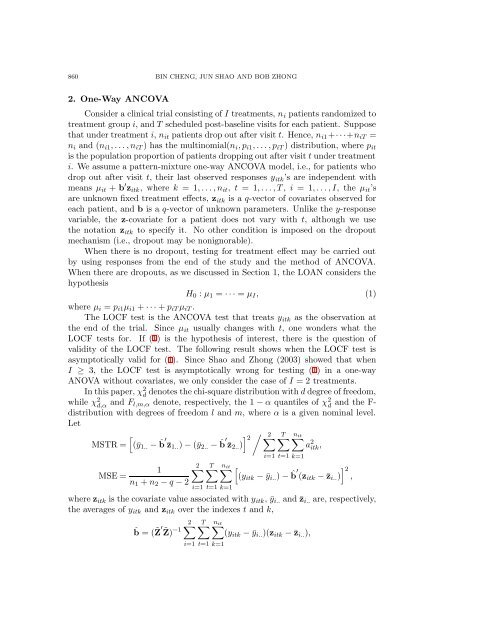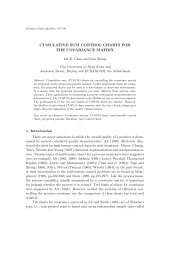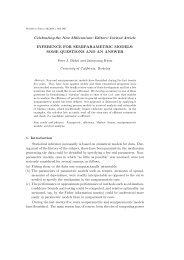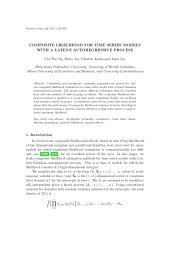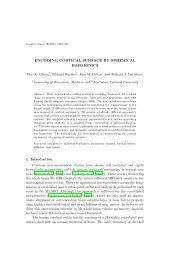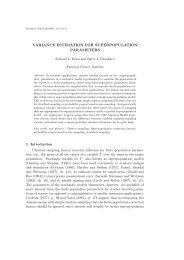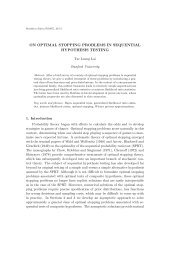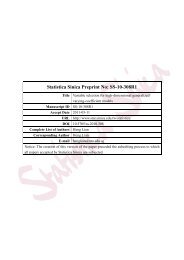last observation analysis in anova and ancova - Institute of Statistical ...
last observation analysis in anova and ancova - Institute of Statistical ...
last observation analysis in anova and ancova - Institute of Statistical ...
Create successful ePaper yourself
Turn your PDF publications into a flip-book with our unique Google optimized e-Paper software.
860 BIN CHENG, JUN SHAO AND BOB ZHONG2. One-Way ANCOVAConsider a cl<strong>in</strong>ical trial consist<strong>in</strong>g <strong>of</strong> I treatments, n i patients r<strong>and</strong>omized totreatment group i, <strong>and</strong> T scheduled post-basel<strong>in</strong>e visits for each patient. Supposethat under treatment i, n it patients drop out after visit t. Hence, n i1 +· · ·+n iT =n i <strong>and</strong> (n i1 , . . . , n iT ) has the mult<strong>in</strong>omial(n i , p i1 , . . . , p iT ) distribution, where p itis the population proportion <strong>of</strong> patients dropp<strong>in</strong>g out after visit t under treatmenti. We assume a pattern-mixture one-way ANCOVA model, i.e., for patients whodrop out after visit t, their <strong>last</strong> observed responses y itk ’s are <strong>in</strong>dependent withmeans µ it + b ′ z itk , where k = 1, . . . , n it , t = 1, . . . , T , i = 1, . . . , I, the µ it ’sare unknown fixed treatment effects, z itk is a q-vector <strong>of</strong> covariates observed foreach patient, <strong>and</strong> b is a q-vector <strong>of</strong> unknown parameters. Unlike the y-responsevariable, the z-covariate for a patient does not vary with t, although we usethe notation z itk to specify it. No other condition is imposed on the dropoutmechanism (i.e., dropout may be nonignorable).When there is no dropout, test<strong>in</strong>g for treatment effect may be carried outby us<strong>in</strong>g responses from the end <strong>of</strong> the study <strong>and</strong> the method <strong>of</strong> ANCOVA.When there are dropouts, as we discussed <strong>in</strong> Section 1, the LOAN considers thehypothesisH 0 : µ 1 = · · · = µ I , (1)where µ i = p i1 µ i1 + · · · + p iT µ iT .The LOCF test is the ANCOVA test that treats y itk as the <strong>observation</strong> atthe end <strong>of</strong> the trial. S<strong>in</strong>ce µ it usually changes with t, one wonders what theLOCF tests for. If (1) is the hypothesis <strong>of</strong> <strong>in</strong>terest, there is the question <strong>of</strong>validity <strong>of</strong> the LOCF test. The follow<strong>in</strong>g result shows when the LOCF test isasymptotically valid for (1). S<strong>in</strong>ce Shao <strong>and</strong> Zhong (2003) showed that whenI ≥ 3, the LOCF test is asymptotically wrong for test<strong>in</strong>g (1) <strong>in</strong> a one-wayANOVA without covariates, we only consider the case <strong>of</strong> I = 2 treatments.In this paper, χ 2 ddenotes the chi-square distribution with d degree <strong>of</strong> freedom,while χ 2 d,α <strong>and</strong> F l,m,α denote, respectively, the 1 − α quantiles <strong>of</strong> χ 2 d<strong>and</strong> the F-distribution with degrees <strong>of</strong> freedom l <strong>and</strong> m, where α is a given nom<strong>in</strong>al level.Let[MSTR = (ȳ 1.. − ˆb ′¯z 1.. ) − (ȳ 2.. − ˆb ′¯z ] / 2 2∑ T∑ ∑n it2.. )a 2 itk ,i=1 t=1 k=112∑ T∑ ∑n it [MSE =(y itk − ȳ i.. ) −n 1 + n 2 − q − 2ˆb ′ 2(z itk − ¯z i.. )],i=1 t=1 k=1where z itk is the covariate value associated with y itk , ȳ i.. <strong>and</strong> ¯z i.. are, respectively,the averages <strong>of</strong> y itk <strong>and</strong> z itk over the <strong>in</strong>dexes t <strong>and</strong> k,2∑ T∑ˆb = (˜Z ′ ∑n it−1 ˜Z) (y itk − ȳ i.. )(z itk − ¯z i.. ),i=1 t=1 k=1


